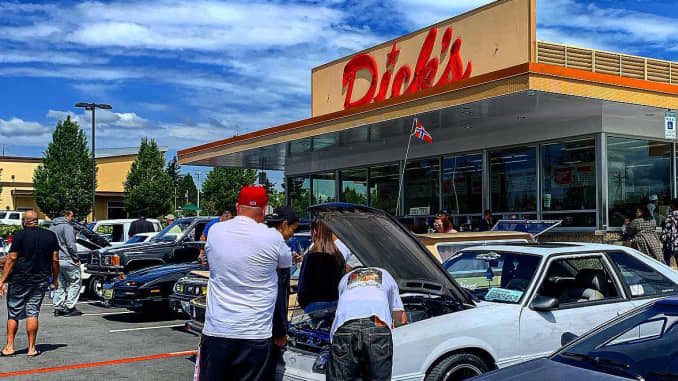When Seattle began raising its minimum wage five years ago, local burger joint Dick’s Drive-In experienced an unintended effect.
Its employees opted to work fewer hours as their wages rose, a tall order in a tight labor market.
“We thought with higher wages it would be easier to get people to take more hours, but it’s been the opposite,” said Jasmine Donovan, president of Dick’s. She added that the company has had to raise prices for the first time in its history because of the cost of labor alone, whereas in the past, food costs drove such hikes.
Seattle’s law, which gradually increases its minimum wage to $15 an hour by 2021 from just over $9 an hour in 2014, is now at the forefront of a national debate over the impacts of progressive wage increases. It comes at a time when top Democratic presidential candidates like Bernie Sanders and Joe Biden are calling for a $15 per hour federal minimum wage as they try to appeal to working-class voters. The federal minimum wage is currently $7.25 an hour and has not been increased in over a decade.
“Seattle was catalytic to the entire national movement because what the Seattle City Council did by passing the law was show the entire nation that $15 was not a ridiculous demand that people were laughing at back in 2012, but an actual key piece of policy that allowed for working people all across that city to have more money in their pockets that they spent in their local neighborhoods and then grew the economy and local business as a result,” said Mary Kay Henry, president of the Service Employees International Union, which launched the Fight for $15 and a Union campaign.
Businesses like Dick’s have seen their costs go up. Dick’s pays above minimum wage, with some locations starting workers at $17 and $18 an hour, and most workers are students in their 20s. Benefits like 401(k) plans and health insurance are also available to workers regardless of the number of hours worked. But higher minimum wages citywide pressure employers to increase pay even if they are already above that threshold, in order to compete for talent.
Meanwhile, the Seattle law has been life changing for workers like Martin Johnson, who lobbied for higher pay with the advocacy group Working Washington. He works three minimum wage jobs — as a temporary cook on game days at the city’s stadiums, as a janitor at Costco on the overnight shift and as a handyman in his own small business. The raise brought with it more dignity for workers and boosted morale, he said.
“Instead of being paid $9 an hour, you’re getting $15 an hour to do the same work. You feel better about yourself — you feel appreciated,” Johnson, 54, said.
Overall, implications for businesses and workers alike have been nuanced. While there are benefits for workers who saw higher pay, others may have seen fewer hours. Some businesses flourished, while others struggled in the face of greater regulation and intense competition in the city’s hot economy.
No consensus among economists
Studies of the effects of the Seattle wage hike have had different findings: A 2017 University of Washington study found that while wages went up, hours worked declined, resulting in less pay for low-wage workers. But in a follow-up published last year, the authors noted that this wasn’t the case for everyone, and experienced workers in low-wage jobs saw their earnings rise.
Another from researchers at the University of California, Berkeley released in 2018 found that the wage hikes increased pay and have not led to job losses. The Berkeley and Washington studies measured different groups of workers, with varying results.
The conflicting studies highlight a broader debate about what a $15 federal minimum wage might do for businesses and workers nationwide. Federal Reserve Chairman Jerome Powell even touched on the issue during his testimony before the House of Representatives this summer saying. “there is no consensus among economists … economists are all over the place on this.”
One of the challenges of measuring Seattle’s experience with the minimum wage hike is that the city’s economy is in a period of robust growth. Since the wage increase began in 2015, Seattle/Tacoma’s job growth has slightly outpaced the state of Washington as a whole, at 12.9%. The city’s population has increased some 13% over 2015, according to the Washington state Office of Financial Management. Average hourly earnings were $39.38 in October, an increase of 14.5% from the same month in 2015.
That prompts a question: Are higher wages necessary due to the hot economy, or has the economy continued to grow due to higher pay?
Mixed results for businesses
When the minimum wage increase in Seattle passed, Chad Mackay, CEO of Fire & Vine Hospitality, a Pacific Northwest hospitality group, he decided to reevaluate his business model.
“When we projected out the minimum wage increases, and the loss of a tip credit [which allows employers to count tips toward minimum wage], we realized we would be functionally bankrupt if you were to fast forward seven years in the future. We decided the business model was broken, and it’s time for us to change,” Mackay said.
Fire & Vine has long paid above minimum wage in the front and back of house due to demand for talent in the market and the company’s beliefs on professional pay. The company moved to a commission-based model, with a 20% service charge for diners. Servers are paid out an hourly wage and a 15% commission and can make $70 or more per hour in the Seattle market, up from some $45 an hour earlier. Guests can also leave extra tips for servers if desired. Those in the back of the house like dishwashers begin between $17 and $20 an hour — some 40% over where they were prior.
The wage increases haven’t hurt his business: He’s nearly doubled in size, with some 600 workers today with 12 locations under management, during a time when other restaurants have closed their doors.
“Once we went to that model, I have never worried about minimum wage. And I’m not sure there’s a restaurateur in Washington state or in California or New York, that can say, ‘We left behind minimum wage as an issue for our company,’” Mackay said.
But while some businesses have thrived, others have faced challenges in the face of Seattle’s changing economy.
Matthew Dillon, owner of Sitka & Spruce, says that he believes the minimum wage should be much higher than $15 an hour, which is why he also pays workers above that threshold. But when his lease came up, the James Beard Award-winning chef decided it was time to close his doors after more than a decade in business, serving the restaurant’s last dinner on New Year’s Eve. Passing off costs to consumers in an environment where his rent was $16,000 per month including taxes and fees, and where both food and labor costs are also on the rise, felt unsustainable. He has other businesses that are still up and running in the area.
“Wages are going up, the price of food is going up, [and] my property taxes that I have to pay the landlord are going up. My rent is going up for my staff, or staff that was here feels like, ‘Well I can’t be in the city anymore, so you have to find someone to replace me,’” he said. “That’s really hard. The cost of that, just working through that as a business owner, is going up.”
It’s an issue Eric Tanaka is also contending with. The partner at Tom Douglas Seattle Kitchen says the group also decided not to renew a lease for a building that houses three of its restaurants — TanakaSan, Assembly Hall and Home Remedy. Moving forward, Tanaka says he may consider less labor-intensive models, as well as concept and menu tweaks, within the group’s different businesses as costs have gone up and talent can be tough to find in the city. The company pays above minimum wage and offers benefits for those working more than 25 hours a week. It recently settled a class-action suit with its employees over service fee charges.
“I think as we start to look at future planning, we are definitely looking at restaurant models that take less labor,” Tanaka said.
That could be tough given that his restaurants make things from scratch. “It’s hard to be handmade without the hands. But we are looking at different ways to leverage those hands,” Tanaka said. “It’s a challenge every day because there are less and less people who want to get into our industry.”











